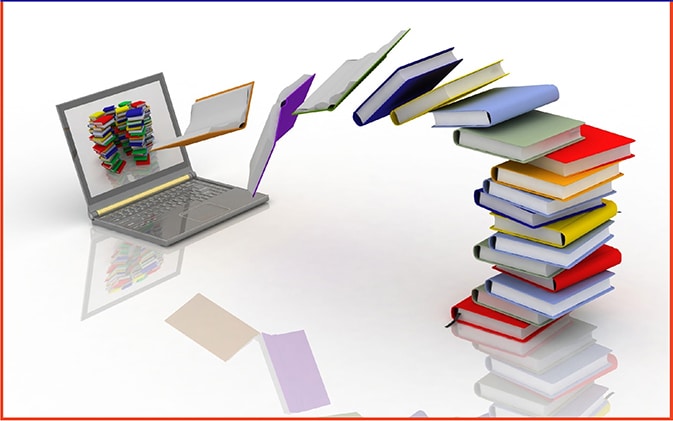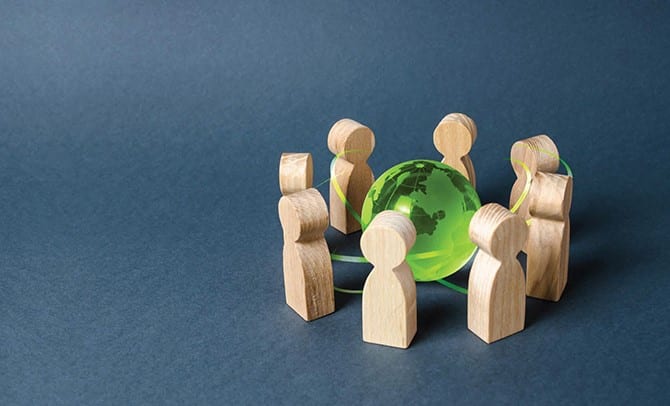
How to Design Professional Development that Staff Want to Attend
August 5, 2019
Technology in Jewish Education: Values and Accessibility
June 3, 2020by DR. SARAH LEVY and MARK PARMET
The 21st century skills (1) of communication, collaboration, creativity, and critical thinking are all skills that are essential to the study of Jewish text and have been part of our tradition for generations. The traditional format of text study has been though chevruta, an intense partnership that demands collaboration and communication between two people, and the method has been to question the text and to use critical thinking skills to consider what is being said. Creativity, chidush in Hebrew, also often comes into play in this traditional format of study. These skills that have been so essential to the tradition of Jewish education for thousands of years have also been identified as the skills that are vital for today’s world and have been the focus of educational practice and scholarship for the last 20 years.
While the details related to the focus and purpose of education can be debated, the main goal is pretty unanimous: to prepare students for success in their lives. Jewish day schools are not exempt from this work. Although we ground our approach in Torah values and timeless texts, we have an obligation to prepare students for the world in which they live, so that they can be successful both today and tomorrow. We must also give them an opportunity to live their values, put their learning into action, and impact the world around them, and the best way to do that is to emphasize and integrate a strong focus on 21st century skills.
A challenge arises, however, in considering how to measure our success in this area. We know when a student has learned math and can carry out a complex problem. We know when a student knows Torah and can analyze the parsha and connect two different narratives. We know when a student can write a well-articulated persuasive essay. But how do we know a student is creative or can collaborate? How do we assess these 21st century skills at the same level that we are able to assess in other areas? How do we know we’re doing what we say we’re doing in this area?
Step 1 – What are you assessing?
Before determining how to assess these 21st century skills, you must first determine which skills you are prioritizing and teaching and what they look like. While the skills we most often refer to are known as the 4 Cs – communication, creativity, collaboration, and critical thinking – schools need not be bound or limited to these. Consider what is important to you as a community and what is most aligned with your vision of a successful graduate.
In general, these skills can be broken down into three categories: cognitive (such as critical thinking or creativity), interpersonal (such as communication, collaboration, leadership, or global awareness and connection), and intrapersonal (such as time management, grit, and growth mindset), and it is important to emphasize a mixture of skills from different categories.
When choosing skills of emphasis, make sure that the selected skills do have importance to your population, that you believe (and/or there is research suggesting) that educators can influence student mastery of these skills, and that you can define the skill well enough that it can be assessed. Also, while one could make the case for the value of every one of these skills, try to narrow your focus to four to eight skills in order to thoughtfully and meaningfully integrate them into your program.
Once you have identified your skills of focus, take the time to define them. For example, what does “creativity” mean to your school? Why is it important and how is this skill beneficial to students?
The next step is to think through what these skills look like at your school, breaking each skill down into observable (and accessible) bullet points. This is a place to consider how these skills progress as students get older. For example, collaboration as a kindergartener could (and should) look very different from collaboration as an eight grader or high school senior. What do these skills look like in each grade? How does the development of these skills build from one grade to the next? What observable measures could you expect to see for each of these skills in the classroom?
Step 2 – Why are you assessing?
Before determining how to assess these skills, you must first consider why you are collecting data in the first place and what you plan to do with the data once collected. In general, there are four main reasons for which a school would collect data on these skills (or any skills, for that matter): monitoring system performance, holding people or the school accountable for student learning, establishing priorities by valuing the assessed skills, and supporting instructional improvement. While all four of these reasons could be important to a school, this last reason (supporting instructional improvement) is the most compelling as it is directly connected to student learning and outcomes.
Having a sense of why you are assessing and what you plan to do with the data is an important step. Knowing what you plan to do with the data should inform the kind of data (and frequency) you plan to collect.
Step 3 – How are you assessing?
The next step would be to consider how you are assessing these skills. Considerations for assessing these skills and choosing measures of assessment can be broken into three major categories: instructional (formative/summative, use of feedback for students, use of feedback for teachers, age appropriateness), practical (cost, ease of implementation, ease of scoring), and technical (reliability, validity, fairness). Each of these aspects plays a role and must be considered in relation to the others. For example, is the reliability of this data worth the cost that it takes to collect it (both in terms of class time and money)?
Some types of assessment measures to consider include:
- Purchased assessments (usually multiple choice) – Companies are working to develop tools that can be used to assess some of the 21st century skills in a way that gives objective, quantitative data. Tools like PARCC and Smarter Balanced are used in schools across the country for this purpose.
- Student portfolios – Collecting student work over the year or the student’s career at the school as it pertains to specific skills can be a valuable tool for students and parents (as well as teachers) to observe growth in specified areas.
- Performance assessments – Simulating real-world experiences and giving students authentic opportunities to employ their learned skills can be a powerful method of assessing.
- Student observations – Some skills like collaboration may be best assessed by simply watching the students collaborate, noting strengths and areas of growth while they navigate different situations.
While purchased tools can have benefits such as objectivity and consistency, research has shown that assessments requiring more teacher involvement – any of the last three assessment types – can positively influence attitudes and beliefs about teaching, inform curriculum and instruction in meaningful ways, and change how teachers go about measuring skills in their own classrooms. When employing measures such as portfolios or observations, a rubric should be used in order to guide the assessment. There is no one tool that will work for every school to assess every skill, so make sure to prioritize what you are assessing against convenience and other factors.
Just a few notes to keep in mind as you consider how you are assessing these 21st century skills:
- Make sure that the data you are collecting aligns with what you are trying to measure. Data that is inexpensive and easy to collect provides no benefit to the school, teacher, or student if it doesn’t directly correlate to the specific skill you are assessing.
- Try to avoid subjectivity as much as possible. If student observations play a role in your assessment practices, develop a simple tool and invite more than one teacher to collect data on each student.
- Ensure your teachers are properly trained and that they fully understand any tool you use. As for the tool itself, the simpler the better.
Additional Considerations
Defining, teaching, and assessing 21st century skills is much easier with the buy-in of the faculty, students, and parents. Consider opening up this process to different stakeholders in order to build support and consensus. Ask parents which skills are most important to them. Ask students what each skill looks like to them. As teachers what data would be most usable to them.
There will always be a degree of ambiguity with the definition and assessment of 21st century skills. There is an element of subjectivity involved in this work, and everyone involved has connotations and experiences that come into play. Try to define the process as much as possible in order to clarify to the extent that you can.
Consider ahead of time what will happen with the data and how that will be used to inform instruction, and make sure to prevent the use of this data being used to label students. Have a plan in place for teachers to review data and make changes to their instruction. Consider how the data will be reported to students and/or teachers. Make sure to connect back to the “why” you are collecting the data in the first place.
Context and culture matter, and what works at one school with one group of students and teachers won’t necessarily work at another. Learn from what others are doing, but make sure you adapt for your own population and purposes.
Educators, administrators, and learning scientists still do not know as much about the teaching and learning of 21st century skills as they do about teaching traditional academic competencies (reading, writing, math), so there is a bit of experimentation and iteration required for this work, and expectations (for teaching, learning, and assessment) should be realistic.
As with assessing any student or any learning, a comprehensive assessment strategy should be employed in order to fully understand student growth. Assessing any one of these skills based on piece of student work won’t give the full picture of the student’s ability in that area, so ensure you have systems in place to assess frequently and in a variety of ways.
Aim for consistency between teachers and students. Make sure that these skills are prioritized and emphasized school-wide, as well as defined in a school-wide manner. While these skills look different for students in different grades, and it is appropriate to emphasize one skill over another at different times, students in various grades and with diverse teachers should be receiving consistent messaging.
Judaic studies should not be an area exempt from a focus on 21st century skills, but, rather, should be an important area of integration. The 21st century skills so easily lend themselves to the realm of Judaic studies and can work towards engagement and relevance for students.
While 21st century skills can be challenging to teach and assess, they play an essential role in educating our children today, and Jewish day schools can (and should be) at the forefront of this work. After all, we have a lead of a few thousand years in emphasizing and valuing these skills, so the rest of the educational community just has to catch up!
Dr. Sarah Levy and Mark Parmet as the co-founders and heads of school for Einstein Academy, a new private school located in Denver, CO. Te have a combined 35 years of experience in education, including youth and family education, adult education, and day school education. They can be reached at
[email protected] or [email protected].
(1) Note: Success skills, future ready skills, 21st century skills or competencies are all terms that are used in the same context. For our purposes, all of these terms are synonymous, but for consistency, we will be using the term “21st century skills.”

